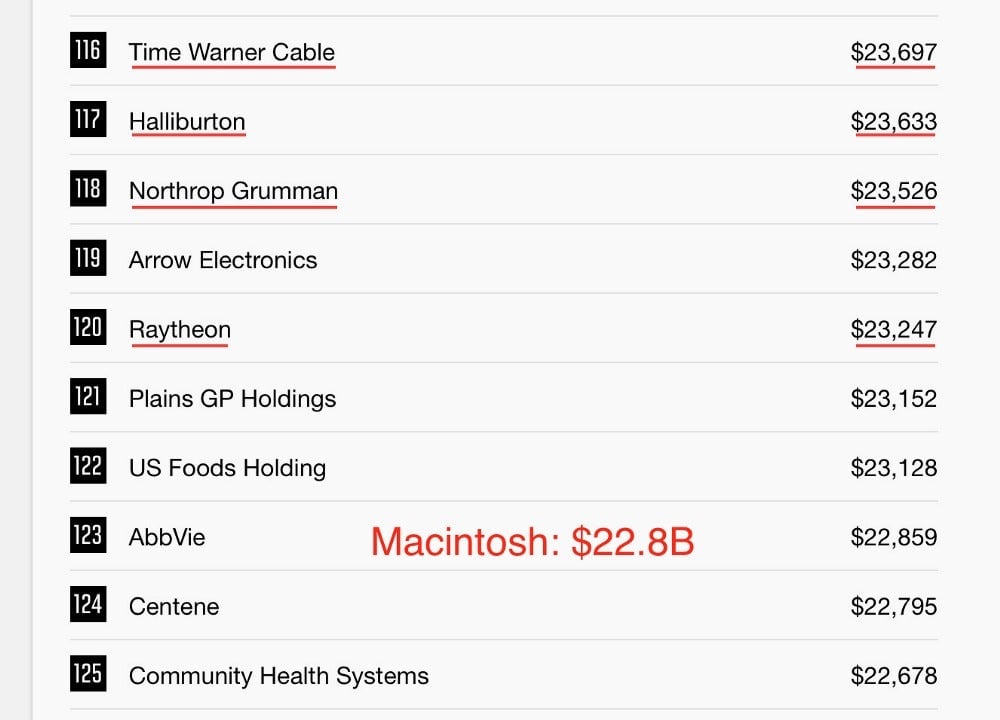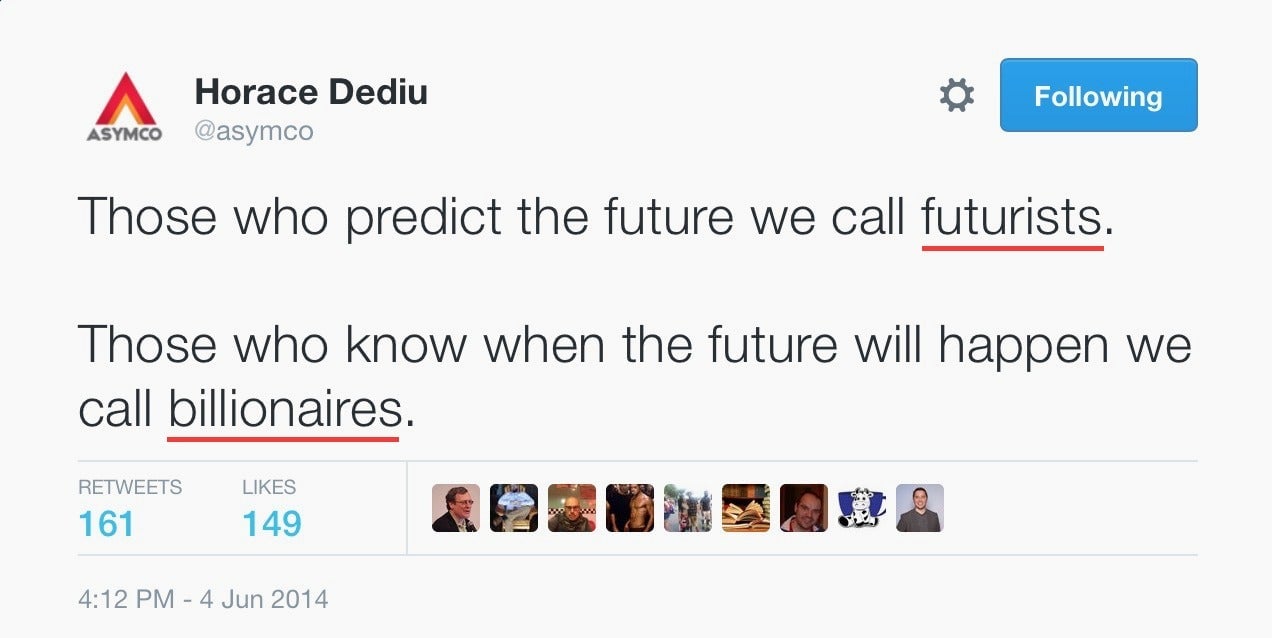Apple’s laptops are doomed to same grim fate as the rest of the PC market
The Macintosh line of personal computers will soon be 32 years old. It has a venerable pas. But what kind of future does it have in a declining market?


The Macintosh line of personal computers will soon be 32 years old. It has a venerable pas. But what kind of future does it have in a declining market?
On the surface, the Mac appears to be thriving. If “Macintosh Inc.” were an independent company, its $22.8 billion in revenue for Apple’s 2016 accounting year (which ended in September) would rank 123rd on the Fortune 500 list, not far below the likes of Time Warner, Halliburton, Northrop Grumman, and Raytheon:

But there’s more to the Mac’s future than its current good numbers. After enjoying a good time in the sun, the Mac is on the same downward slope as the rest of the PC market.
What do you do when your business is part of a declining world? Do you decrease prices to gain market share? Bad idea; this is the PC clone makers’ race to the bottom, a game in which everyone loses as products become commoditized, undifferentiated, and, ultimately, worthless. This is what Hewlett-Packard did when it bundled its PCs and printers (another commoditized product category) into a new entity called HP, Inc…. and then discreetly placed the business out by the curb. Recent numbers show a measly 4.3% operating profit for HP’s PC line. Comparable (not disclosed) Mac numbers are said to be in the 25% or more range.
Instead of racing to the bottom as the market plummets, Apple appears to be taking the “high road,” in a sense: They’re taking refuge at the high end of the market by introducing new, more expensive MacBook Pros, with a visible differentiating feature: the Touch Bar. This is known, inelegantly, as milking a declining business, although you shouldn’t expect Apple to put it that way.
Apple’s recognition that the PC market is declining also explains why the company has been slow in updating its laptops and desktops. The iPhone, with $136 billion in revenue for 2016, is a much higher priority and gets more development resources. In a war, the top general puts more and better troops on the most important battle.
Will the PC category keep declining until it disappears? It happened to the MP player genre: In 2006, the year before the “Jesus phone,” the iPod generated more revenue than the Mac, but it was ultimately absorbed into Apple’s new creation.
Many thought something similar would happen with the iPad and the Mac. “Someday, the iPad will replace the Mac!” was a common belief supported by the iPad’s meteoric rise. Indeed, by 2014, iPad revenue ($30 billion) had surpassed the Mac ($24 billion); but after three years of growth, iPad revenues went south and soon fell below Mac numbers. In 2016, the iPad only brought $20.6 billion against the Mac’s $22.8 billion.
For the Mac versus iPad question, Apple execs offer a clean dichotomy:
- On one side, we have the Mac with a vertical screen and a keyboard+touchpad for input. Your never have to raise your hand. The Touch Bar is an extension of that interaction model. The trackpad, now even larger on new models, provides one, two, three, or even four-finger inputs with very fine cursor control.
- On the other, we have the intuitive iPad with its simple user interface driven by fingers directly on the screen. Oh, and the Pro versions offer a keyboard and a stylus—pardon, a Pencil. And it exposes the file system via the iCloud Drive app that also lets you see your Mac desktop and documents. And the Split View feature lets you open two windows and run two apps side by side on your tablet.
To an uninformed observer, the dichotomy isn’t so clean: The iPad looks likes its turning into the hybrid PC-tablet interaction model promoted by Microsoft Surface devices. Microsoft contends that the Surface hybrid, now in its fourth iteration, is the best-of-both-worlds that their customers want. Apple maintains that the Microsoft implementation is kludgy, that traditional Windows Office apps were designed for the fine cursor control afforded by a mouse, not for the much coarser touch area of a finger.
(In discussing its latest quarterly results, Microsoft pegged Surface devices numbers at $926 million—about $4.4 billion for the last four quarters. Again, the Mac and iPad boasted $20 billion+ each for the same time period. A difficult comparison between different product philosophies.)
The story doesn’t get simpler: What if, in a not-too-distant future, Apple introduces an iPad with a keyboard and a pixel-precise trackpad? Perhaps not as large and capable as the one on Mac laptops, but a trackpad nonetheless. The increasingly blurry difference between an Apple PC and an Apple tablet could become even less clear.
And still there’s more.
I write this on a MacBook running on a 1.2 GHz Intel processor. (It’s the best laptop I’ve ever owned—small, great “Retina” screen for my old eyes, and light as a 12.9″ iPad Pro and its cover.) My iPhone 7+, which I sometimes use as a cellular modem for my MacBook, runs on a 2.34 GHz A10 processor that is, in many respects, more muscular than my Macbook’s CPU.
This is becoming ridiculous and inevitably raises another version of the Mac vs. iPad question. In a fantasy world, Apple produces an Ax-based Mac. Easy enough as the company controls its silicon and software tools, and the organs that are common to iOS and MacOS already run on both ARM and Intel CPUs. But what would an Ax Mac mean in the real world, to software developers? The mind reels at the thought of yet another upheaval as developers rush to convert third-party Mac apps.
Or will they? With hundreds of millions of iOS devices sold year after year, and ever more software engineering resources allocated to the platform, iOS-based hardware will win the day. The billion dollar question, here, is when? As Horace Dediu a.k.a. @asymco put it in a June 2104 tweet:

In the end, iOS numbers make the decision. For its part, Apple will stay out of the way and let customers—and developers—decide when it’s time to buy the last Mac.
PS: I’m not ignoring the new MacBook Pros. I’ll let the clickbait dust settle first and deal with the new laptops, and their perplexing launch, once I’ve had the opportunity to own and operate one. Today, MacBook Pros still look like they’re made of a rare metal called unobtainium. The Palo Alto Apple Store says I can pick one up on Jan. 2nd—2017.